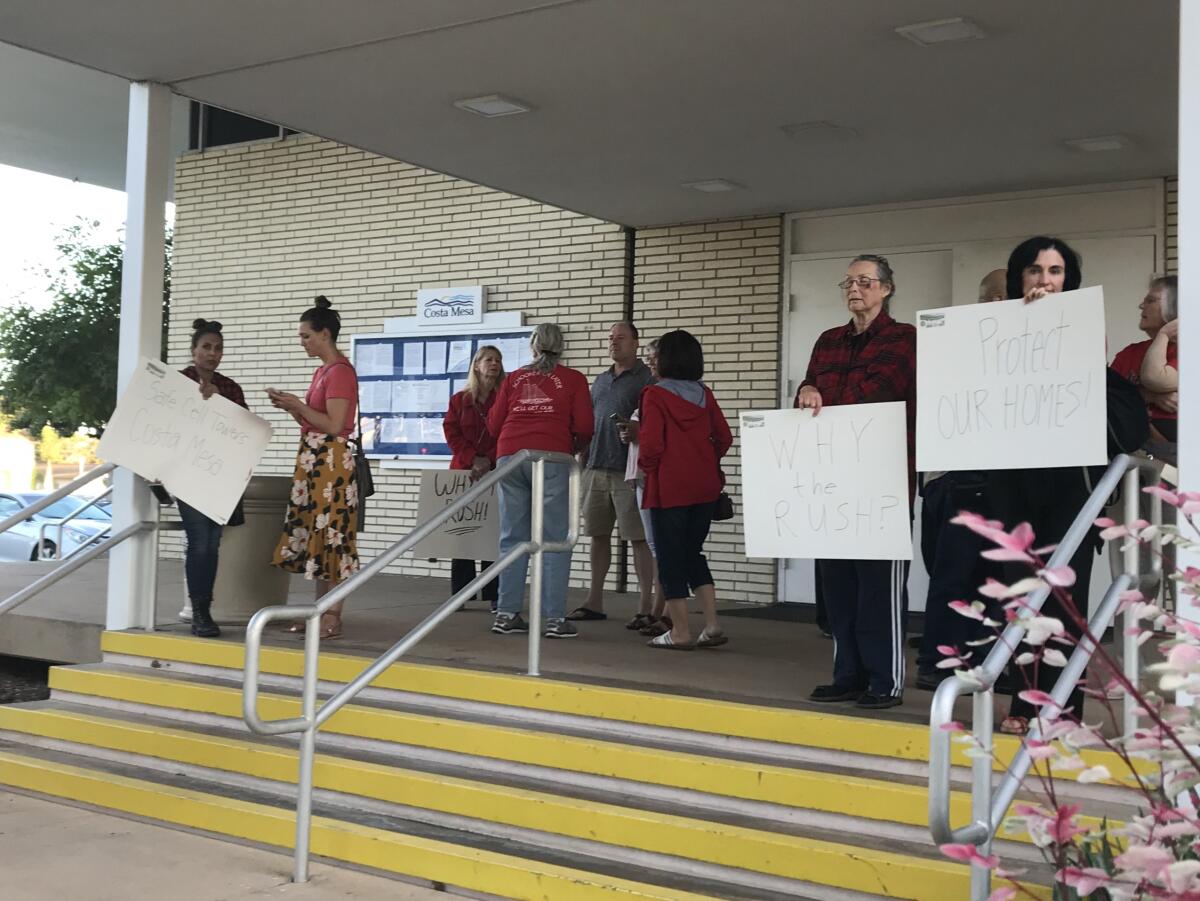Costa Mesa moves ahead with changes to high-speed wireless infrastructure, despite protests from residents

- Share via
The Costa Mesa City Council approved a set of changes to the designs of wireless technology boxes, despite a barrage of complaints from protesters who stayed late into the night Tuesday to express worries about 5G technology.
The issue on the table involved small cell facilities — the boxes containing wireless technology that provide cell coverage around the city. Protesters said the small cell facilities may pose health threats and complained about the boxes’ designs.
The council first took up design guidelines for small cell facilities in spring 2018 but brought it back Tuesday for modifications to make the designs more amenable to residents while staying within federal requirements.
About a dozen protesters gathered outside the council chamber at City Hall before the meeting, sporting bright red shirts and carrying signs such as “Protect our homes!” and “Safe cell towers Costa Mesa.” The group scattered throughout the chamber once the meeting started.
At the heart of the protesters’ concerns is the potential upgrade to 5G technology, a mostly uncharted territory that many activists feel could endanger public health because of the use of higher-frequency radio waves.
5G is a fifth-generation wireless network that is intended to increase internet speeds and provide more-reliable connections. The radio waves would be transmitted via the small boxes to a variety of devices, from smartphones to self-driving cars.
After a couple of hours of discussion, the council voted 6-1 to adopt design guidelines that rank the places where small cell facilities can be placed — in order of preference, light poles, traffic signal poles, utility poles and new standalone poles.
The city also will prioritize poles in non-residential zones. Those in residential neighborhoods must be at least 25 feet from a residence and 60 feet from the driveways of schools, police and fire stations or other emergency facilities.
Councilman Allan Mansoor, who cast the lone dissenting vote, argued that too many small cell facilities on neighboring poles could present an aesthetic issue.
“It’s too many; it’s an over-concentration,” Mansoor said. “We want to all have cellphone service, but you don’t want to have it all in one spot.”
To that end, the council added a provision that poles containing small cell facilities from the same provider must be at least 500 feet apart.
The vote also mandated that the facilities cannot block public art or historical buildings or alter landscaping.
The meeting grew contentious at times as some audience members applauded protesters’ speeches and lashed out against council members. Their interjections caused Mayor Katrina Foley to repeatedly call for order.
The federal government limits where cities can put wireless service facilities, as well as construction of and any changes to small cell sites.
City Attorney Kimberly Hall Barlow repeatedly emphasized that the issue of radio emissions doesn’t fall under the council’s jurisdiction. She and council members encouraged residents to contact members of Congress and the Federal Communications Commission, which regulates wireless technology.
“Any type of lawsuit or any attempt to fight these federal regulations would be a loser,” said Mayor Pro Tem John Stephens. “It’s just not a good use of taxpayer money.”
The FCC does allow cities to make rules guiding the design of small cell facilities, which is where activists feel they have the most leeway.
Alison Burchette, a senior account executive at Salesforce, a cloud-based software company, received a cheer from the audience when she implored the council to exercise “a little bit of balance” to help protect Costa Mesa homes and schools.
“I am not anti-technology,” said Burchette, who brought her young daughter to speak at the meeting. “My No. 1 concern is our children’s safety. … The 5G roll-out definitely poses a risk to public safety.”
The FCC requires all wireless communications devices to meet “minimum guidelines for safe human exposure to radio frequency,” according to an article on its website.
“Some health and safety interest groups have interpreted certain reports to suggest that wireless device use may be linked to cancer and other illnesses, posing potentially greater risks for children than adults,” the website states. “While these assertions have gained increased public attention, currently no scientific evidence establishes a causal link between wireless device use and cancer or other illnesses.”
If 5G technology is introduced and doesn’t fit the current small cell facilities, the issue may return to the City Council for more updates to the design guidelines.
Other cities around Southern California, including Laguna Beach and Glendale, have taken paths similar to Costa Mesa’s, cautiously paving the way for small wireless cell facilities to accommodate 5G while juggling FCC regulations and residents’ concerns.
Updates
3:56 p.m. Oct. 2, 2019: This article was originally published at 1:16 p.m. and has been updated with additional information.
All the latest on Orange County from Orange County.
Get our free TimesOC newsletter.
You may occasionally receive promotional content from the Daily Pilot.




